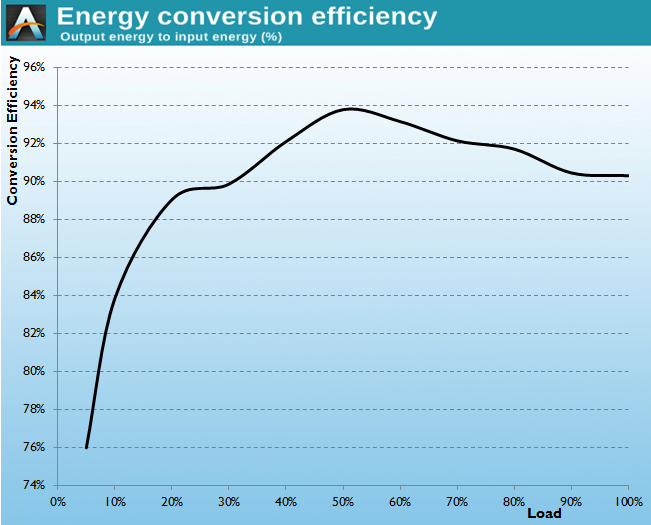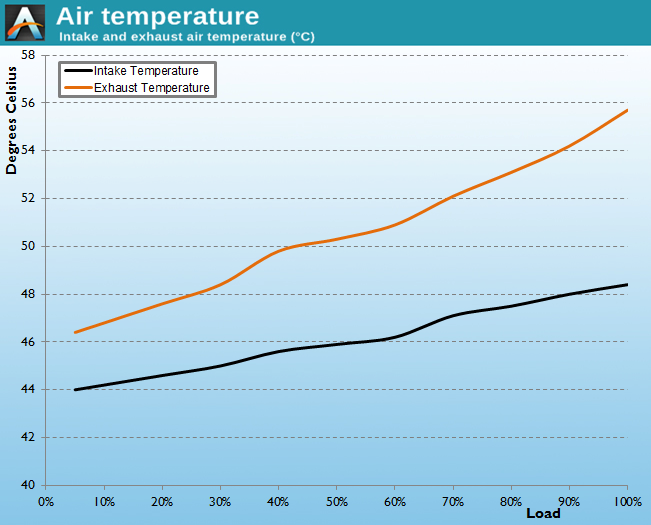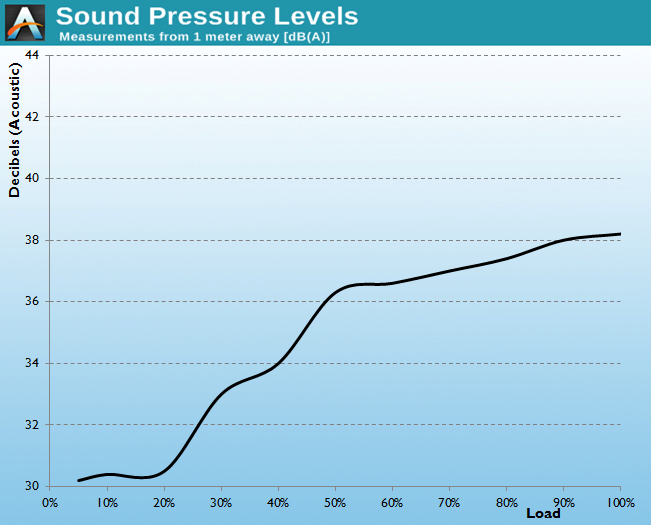Seasonic S12G 650W Power Supply Review
by E. Fylladitakis on February 28, 2014 2:20 PM EST- Posted in
- Cases/Cooling/PSUs
- Seasonic
- 80 Plus Gold
Hot Test Results
From the table below, it can be seen that the output power quality of the Seasonic S12G is very high. The maximum voltage ripple that our instrumentation recorded is a mere third of the ATX design guide suggested limit (the limits are 120 mV on the 12V line, 50 mV on the minor voltage lines), under full load and inside the hotbox no less. Cross-load testing negatively affects the power quality of any power supply but its effect on the Seasonic S12G is small, with the 12V line registering up to 54 mV while delivering 512W. Cross-load testing has virtually no effect on the minor voltage lines, the performance of which did not degrade any further than during standard testing.
| Line |
Regulation (20-100% load) |
Voltage Ripple (mV) | |||||
| 20% Load | 50% Load | 75% Load | 100% Load |
CL1 12V |
CL2 3.3V + 5V |
||
| 3.3V | 2.1% | 6 | 8 | 12 | 14 | 6 | 12 |
| 5V | 2.6% | 8 | 12 | 12 | 16 | 6 | 16 |
| 12V | 1.7% | 14 | 22 | 30 | 46 | 54 | 16 |
The impact that the higher ambient temperature has on the energy conversion efficiency is rather small, reducing the efficiency of the Seasonic S12G by about 0.5% across the entire load range. As such, the Seasonic S12G easily retains its 80 Plus Gold efficiency certification status even inside a very hot environment. The average efficiency between 20% and 100% load is an extremely high 91.6%.
The difference between our cold and hot tests is an increase of over 20°C ambient and, naturally, all of the temperature readings increase significantly. We dare say that the temperatures of the heatsinks rise quite a bit beyond our expectations of an 80 Plus Gold unit by Seasonic; however, the heatsinks are rather small and the design of the power supply apparently focuses on low-noise operation, so sacrifices are made in the area of temperatures.
The low-noise aptitude of the Seasonic S12G becomes apparent when we see that the fan hardly exceeds 38 dB(A) under the harshest of conditions, which is an audible figure but hardly louder than three or four 3.5" mechanical disks -- and never mind the GPUs that would be required to hit such loads. Nevertheless, unless you somehow manage to maintain the unit at maximum load inside a >50 °C environment, the Seasonic S12G will not get nearly hot enough to cause problems.














77 Comments
View All Comments
E.Fyll - Saturday, March 1, 2014 - link
That will happen too. Companies (and consumers) generally favor large PSUs at the moment and there are very few high performance, low wattage models. I certainly do not plan on testing high output units alone though, neither focusing on just a single "class" of products. Patience, I can only do one at the time. In time, there will be a good variety of reviews, of every output/range/class.pandemonium - Friday, February 28, 2014 - link
Nice read. I went for the big brother instead about a month ago when my Corsair TX650 decided enough was enough: http://www.newegg.com/Product/Product.aspx?Item=N8...Talcite - Saturday, March 1, 2014 - link
Glad to see PSU reviews have returned!CknSalad - Saturday, March 1, 2014 - link
There's a 360 watt version of this Seasonic brand line. Honestly anything 660/7870 and less just get a quality 360-400 watt psu so your efficiency is also decent under non-gaming/non-intensive loads. 550 watt for a high end single-gpu system (Titan/780 TI/290/290x). GPUs in between those mentioned above a quality 450w psu is good enough.FriendlyUser - Saturday, March 1, 2014 - link
I applaud the newer testing methodology for cases and PSUs. Great job.I am a fan of Seasonic PSUs and have been buying them for a few years. Since I started using Seasonic PSUs I have observed a very low component failure rate for my HD, GPUs etc. Maybe because of very low ripple or because of excellent voltage regulation? Anyway, worth investing in a high-end PSU.
E.Fyll - Saturday, March 1, 2014 - link
Indeed. Most people do not realize that but power quality (ripple/noise suppression mostly) is, in my opinion, by far the most important aspect of a PSU. It hardly affects the performance of the PSU itself but it has a dramatic impact on the longevity and reliability of your system's components.Do not be fooled however, low ripple does not mean low noise; you can easily have a low ripple signal with horrible levels of noise in it. We can only present ripple readings at the moment. We will get a super-fast oscilloscope that can filter noise out of a ripple signal soon; until then try not to confuse these two figures please.
FriendlyUser - Saturday, March 1, 2014 - link
Thanks for the clarification. I really want to see noise figures for PSUs. I would also be curious to see if PSU quality affects analog sound output quality in a measurable way. That would be a cool comparison to make in the future, if you have access to the measuring instruments.tynopik - Saturday, March 1, 2014 - link
Performance when the current is normal and all the components are behaving nicely is boring.We want real torture tests!
- What happens to the output in either severe brownout or overvoltage conditions? What happens when the input is unstable and bounces all over the place? Hook that sucker up to a variac and play with the knob like you're a DJ.
- Transient analysis- aka does the output remain in spec when 10 hard drives spin up at once
- Over-current protection- What happens if a component shorts? What if it just draws a lot more power than it should? Can you melt a cable? Can you blow a fuse? Can you hurt other components on other cables?
FriendlyUser - Saturday, March 1, 2014 - link
Torture tests are only meaningful, in my opinion, if they correspond to possible usage scenarios. Although interesting, the performance of a PSU in situations that will almost never arise should not influence a buying decision.E.Fyll - Saturday, March 1, 2014 - link
And I want a high output, high frequency, programmable AC power source. Do you happen to have 20.000 USD to spare? ;)The VARIAC (oh, I am using one) is entirely useless for the tests that you mentioned. Simply "rotating the knob" is entirely wrong. I will be adding such tests in the future, when I have better equipment available.
As for most of the last tests that you mentioned, these cannot be tested. They are assumptions and performing any one of such "tests" will damage the components of a PSU indefinitely, rendering it useless. For example, if I short the rectifier bridge, it will permanently damage it and probably other components of the PSU as well. Unless you can supply me with 100 units of each model, I cannot test what would happen if every given component would fail.
Oh, and if the distibution grid around your area shifts like "a DJ is rotating the knob", which is not really possible (infinite bus theory), you need to complain to the local authorities, not to the manufacturer of an otherwise proper product. The designer of a PSU is not really to blame if you decide to power it with a voltage signal generated by a pathetic, home-made contraption. Your grid is the problem, start by fixing that.